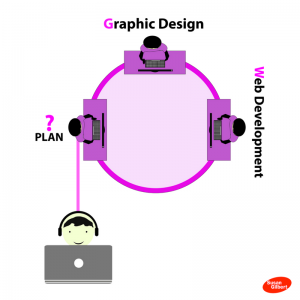All of us rely on patterns, that is a recurrent automated response to help us save time, effort and potentially minimize risk. Sometimes however its necessary to change patterns to grow and improve business performance, that’s the focus of this episode.
Winning at a triathlon if you don’t know how to ride a bike or swim is quite a challenge. I know from experience. When I first started racing, I needed to learn how to ride a bike and to swim. Turns out I took pretty fast to cycling. But swimming, that was another matter. Even though I could muscle my way from start to finish of the swim leg, that didn’t cut it if I wanted to be a contender in a race.
Every time I got in the water; I’d revert to what was familiar – a form of breaststroke. And while I could compensate for this less than successful swimming option by choosing races with shorter swim legs, the only way to truly compete was to learn free style.
And I did. I took all kinds of lessons. And while I become competent in freestyle in practice swims, when it came to race day, I’d switch right back to breaststroke.
It wasn’t until I took the plunge and forced myself to break the pattern that I was able to make that next leap in performance.
This is true for business performance as well. If you want your business to grow, you might need to break some patterns and build new habits.
What is a pattern?
 Patterns generally involve repetitive action, a task or behavior that we engage in frequently, often without giving it much thought. Patterns are something we return to time after time (like the breaststroke), without necessarily thinking about it. When it comes to business patterns, what’s important is figuring out whether the pattern is working for your business or resulting in negative consequences.
Patterns generally involve repetitive action, a task or behavior that we engage in frequently, often without giving it much thought. Patterns are something we return to time after time (like the breaststroke), without necessarily thinking about it. When it comes to business patterns, what’s important is figuring out whether the pattern is working for your business or resulting in negative consequences.
Recognizing and rectifying ineffective patterns falls squarely on the shoulders of the leadership team. As a business leader, with lots of responsibilities and priorities, it can be difficult to make addressing patterns a focus. Especially since the current patterns might actually work – like the breaststroke enabling me to get from the swim start to the swim end.
The problem is that bad patterns lead to poor performance – or in my case, longer race times. In business, bad patterns impact growth. It’s easy to be lax. But to grow and win, you need to have the right patterns along with the processes and systems to support the pattern. Especially if you want to scale.
Breaking a business pattern is a risk. Becoming proficient at a new behavior takes time. The initial performance may actually end up being poorer when you embrace a new pattern. But risk taking is fundamental to growth. Great companies don’t succeed by playing it safe. They are always experimenting and innovating.
4 Patterns Support Growth and Improve Performance
If you’ve identified and eliminated bad patterns, that’s awesome. If not, we hope you will. In the meantime, here are 4 good patterns we’ll hope you consider and implement that will help you grow your business and improve performance.
- Be Proactive. Participants register for a race. In triathlons the registration list and course are published in advance of race day. This allows competitors to research the race and the performance of other participants. We can also read about the course from previous race participants. Most competitors check out the course prior to the race. The pre-race research provides an opportunity to be proactive rather than reactive on race day. It’s vital for business leaders to make conducting research a habit. Research can reveal potential challenges. Invest time daily, aim for 1-2 hours a day, in research by reading articles, listening to podcasts, attending webinars, participating in a peer group, talking and meeting with customers and suppliers. Topics and themes related to industry trends and business management, your customer’s priorities/challenges, competitor moves and world events serve as good starting points.
 Plan to Win. Two contemporaries from the 20th century offer good advice when it comes to planning. “Plans are nothing, planning is everything” attributed to Dwight Eisenhower and “failing to plan is planning to fail” attributed to Winston Churchill. It’s easy for business leaders to get sucked into the vortex of the day-to-day. Lack of strategy and a plan is the equivalent of ‘winging it’. If you don’t currently have a cadence for business strategy and planning, now is the time to create one. Start by analyzing current performance and identifying why things play out the way they do. This provides insight into your current patterns and an opportunity to analyze which ones are working, which ones aren’t and what adjustments are needed. While I became a competent swimmer, it wasn’t my strength. I would always be among the last to leave the water. On the other hand, I’m a good cyclist, especially on hilly courses. This data was useful in selecting races. I l chose races with shorter swim to bike leg ratios and hilly vs. flat courses. In triathlons, every race season deserves a strategy and every race deserves a plan. Different races have different competitors and course challenges. It is the same in business. Make it a monthly habit to gather and analyze performance data, particularly customer data, such as defection, retention and share of wallet analysis and win/loss analysis, to make strategic decisions about customers, markets, and competitors.
Plan to Win. Two contemporaries from the 20th century offer good advice when it comes to planning. “Plans are nothing, planning is everything” attributed to Dwight Eisenhower and “failing to plan is planning to fail” attributed to Winston Churchill. It’s easy for business leaders to get sucked into the vortex of the day-to-day. Lack of strategy and a plan is the equivalent of ‘winging it’. If you don’t currently have a cadence for business strategy and planning, now is the time to create one. Start by analyzing current performance and identifying why things play out the way they do. This provides insight into your current patterns and an opportunity to analyze which ones are working, which ones aren’t and what adjustments are needed. While I became a competent swimmer, it wasn’t my strength. I would always be among the last to leave the water. On the other hand, I’m a good cyclist, especially on hilly courses. This data was useful in selecting races. I l chose races with shorter swim to bike leg ratios and hilly vs. flat courses. In triathlons, every race season deserves a strategy and every race deserves a plan. Different races have different competitors and course challenges. It is the same in business. Make it a monthly habit to gather and analyze performance data, particularly customer data, such as defection, retention and share of wallet analysis and win/loss analysis, to make strategic decisions about customers, markets, and competitors.
- Work the Scenarios. In triathlons unexpected things can happen – tires go flat, people crash, goggles can get kicked off during a swim. Scenarios help you consider possibilities and anticipate what might happen in your market and moves by your customers, competitors or partners. Scenario analysis enables you develop contingencies (enabling you to be more proactive). You can’t create too many contingencies. Engage your team weekly on, “What If..”
- Train and practice. Successful triathletes like most competitors train and practice off and during race season – daily – except for a few days before the race. They leverage coaches and refine processes, such as processes associated with transitions and changing flats. Serious competitors consistently look for opportunities to improve their physical performance as well as address equipment that might give them an edge. They practice and train with new equipment. Experienced racers know better than to run in new shoes or ride a new bike for the first time at a race. And they have training partners. Partners encourage you to up your performance. Some leaders may train and practice with peer groups or send their staff off to training. There’s a lot to be said for doing the training together. Make it a quarterly habit to attend workshops with your team so you and your team to hone skills together. Another key habit of successful competitors is the debrief. This is a valuable pattern in business. Debrief after EVERY “race.”
Frameworks Help Keep Good Patterns Intact
When you’re in the heat of a race, it’s easy to revert to comfortable and familiar patterns. Breaking patterns and creating new ones are essential to growth and performance improvement. Curbing a pattern and embracing a new one takes intention and often external help and new frameworks.
Frameworks are not the same as patterns. Business frameworks capture a process and serve as a roadmap for operating your organization. They support knowledge management and help close experience gaps. Frameworks provide the necessary structure and scope. Choose framework that fit your organization’s culture and situation, enable you to create a common language, and simplify things for you and your teams. Frameworks help keep good patterns intact.
Opportunities for growth are missed when we’re so focused on the race that we don’t work on new patterns that will improve our performance. It might be time to take a hard look at your current patterns and see where there may be opportunities to improve in critical areas, such as customer acquisition, customer retention, new product adoption, and customer lifetime value.
Business & Finance Articles on Business 2 Community
(38)
Report Post







